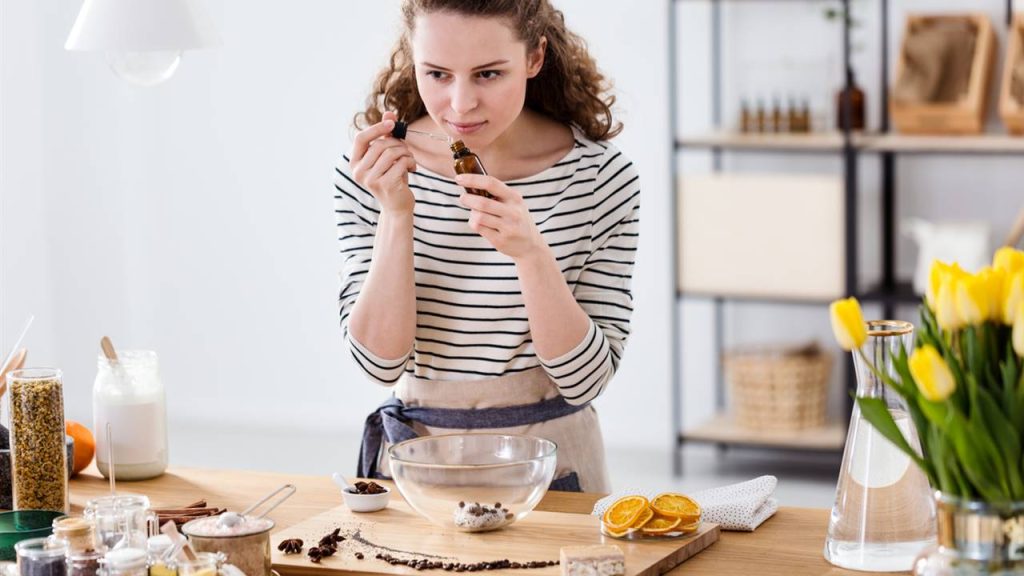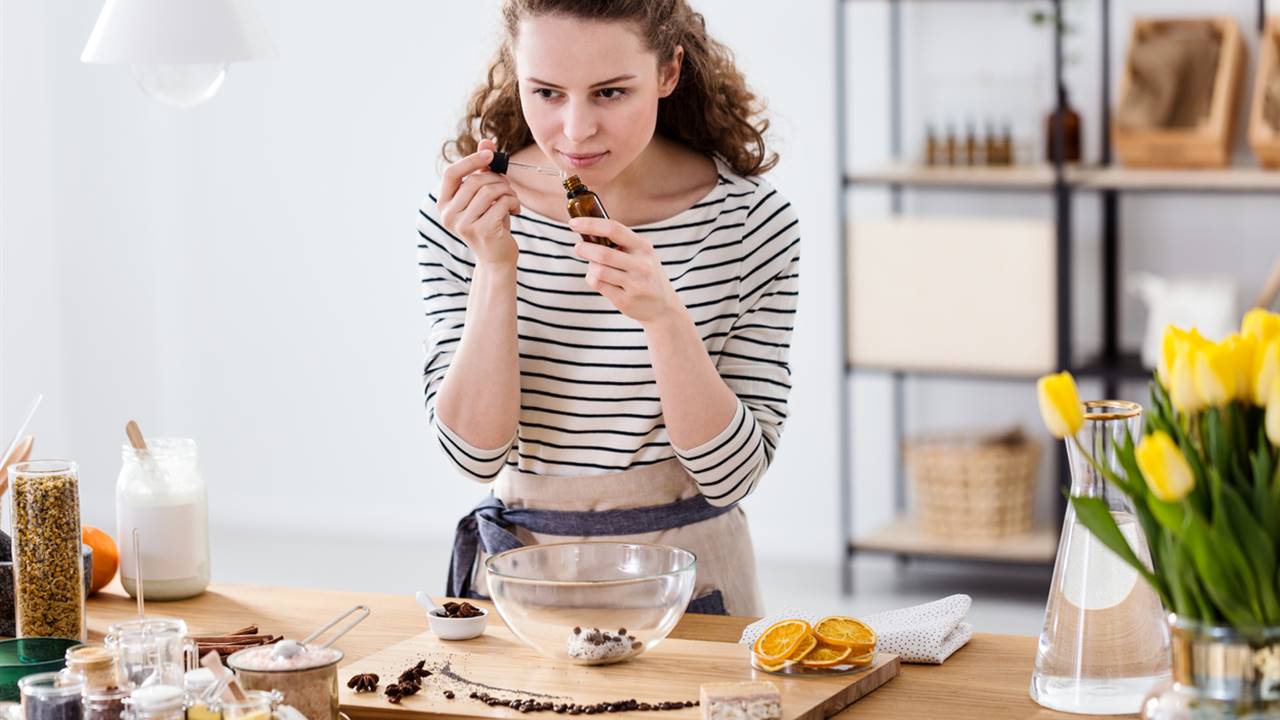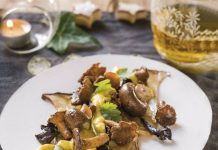Essential oils, by concentrating on them the properties of plants and spices, give dishes intense and unexpected aromas and flavors. Discover them.

- Essential oils suitable for cooking
- How to Use Essential Oils in Recipes
- What essence to use in each recipe
- 4 recipes with essential oils to discover
Essential oils have been used for centuries for medicinal purposes and it is not uncommon to find them as flavorings in some food products, but their possibilities in the kitchen are still little known and including them in recipes can give not a few satisfactions.
Not only do they allow you to intensely enjoy the flavors and aromas with a natural and easy-to-use food, but they will give the dish a different touch.
Essential oils from plants, flowers, spices or fruits are usually obtained by distillation in stainless steel stills. The water vapor passes through the mass of flowers or plants and, when condensed, gives rise to two products: floral waters and oils. The essences are obtained from the cold extraction of citrus peels (orange, lemon, lime …).
Being concentrated, they contain almost all the nutrients of the plant from which they come, which explains their therapeutic use. They are also used diluted in body oils or in devices that distribute their essence in the environment. In the field of aesthetics, they intervene as aromatic agents or for their healing virtues.
They are between 50 and 70% more powerful than the plant itself, and their chemical structure is similar to that of human cells and tissues, so the body recognizes and accepts them without problems.
The food industry has been using essences for a long time due to their great flavoring power, in candies, soft drinks and sweets, and also as ingredients in popular pastry recipes: vanilla or lemon essences perfume all kinds of cakes or cakes.
But in cooking its application is relatively recent and there is a whole field to discover and to be able to experiment.
ESSENTIAL OILS SUITABLE FOR COOKING
They must be oils for therapeutic use, from organic or wild crops, which guarantee the absence of pesticides and the quality of the plants used at source.
It is essential, therefore, to read the labels carefully and avoid synthetic essences or those that do not deserve confidence: only 100% natural oils will be used, which can be found in dietetic stores.
Its therapeutic value will be diminished by the proportions in which they are used and by the action that heat exerts on them, and will be above all stimulating and digestive.
One of the advantages of essential oils is that they allow you to enjoy flavors such as basil, mint or dill when the fresh plant is not on the market.
In addition, the essence is more stable and provides more intense and uniform aromas and flavors, it is easy and quick to use, and allows to give a new air to known sauces and dressings.
Essential oils have nothing to do with vegetable oils, which give a much fattier and unctuous touch, and of which you have to use more quantity to appreciate their flavor.
They can only be used diluted in a fat base or in a syrup, usually olive or sunflower oil, cheese or honey, so it must be taken into account when preparing the recipe.
Among the most used essential oils in cooking are the following:
- Fruit trees: lime, lemon, tangerine, grapefruit.
- Spices: black pepper, cardamom, bergamot, cloves, nutmeg, cumin, ginger.
- Herbal: mint, basil, oregano, dill, fennel, marjoram, lemon balm, parsley, thyme, rosemary, verbena.
- Florals: orange blossom, rose water, chamomile, jasmine, lavender, geranium, ylang-ylang.
HOW TO USE ESSENTIAL OILS IN RECIPES
The main requirement to use essential oils without problems in the kitchen is to use them very sparingly, since they are edible but very concentratedand must always be diluted in a fat so that they do not cause any type of toxicity.
Its aroma is so intense that it requires being very exact with the doses. You also have to take some precautions to avoid poisoning.
- Use a foundation. The essential oil should be diluted in a base of oil, syrup, sugar or a sweet dough, stir well to raise the aroma and flavor. In sweet recipes, cane sugar or honey is used because it complements the essences better and amplifies their flavor.
- Moderate doses. Essential oils have to be added to the base with droppers. One drop of basil, for example, equals 10 g of fresh leaf, so dosage is crucial. In general, 1 drop of essence is added per tablespoon of oil if it is herbaceous or floral, and for two tablespoons if it is spicy and strong. The floral waters are softer and suitable for cold recipes, are dosed with a spoon and do not require so much moderation.
- Don’t mix. To appreciate the intensity of each essence it is not convenient to mix them. Lemon is excepted, which suits ginger, as it complements and softens it.
- Practice with citrus. It is better to start with citrus essences. Those of spices such as cinnamon, ginger or cardamom are strong and have to be measured a lot to obtain balanced aromas. In addition, with citrus essences, especially in pastry, a deeper, uniform and persistent flavor is obtained, avoiding the flavor tips that appear when using skins or zest.
- Better in the end. Unless it is a baked cake, the essential oil is added at the last moment, especially if it is soft. For the strongest (basil, rosemary, oregano) a slow cooking leaves a delicious aroma.
- Rectify it. If the dose has been exceeded, the flavor can be reduced with mild heat, as essential oils are volatile.
- Storage. Once prepared with the base, it is advisable to consume them immediately or store them in the refrigerator.
- Precautions.
- The essences must never be ingested directly, but always diluted, and must always be of quality and natural.
- They should not be given to infants or children under 5 years of age, pregnant or nursing mothers, or people allergic to the original substances.
- Contact with eyes or mucous membranes should be avoided and, in case of accidental contact, washed with gauze soaked in soft vegetable oil, as essential oils do not dissolve in water.
WHAT ESSENTIAL OIL TO USE IN EACH RECIPE
To achieve the desired nuance of flavor, it is advisable to combine prudence with imagination. Discover the tastiest combinations.
- Salads: lemon, lime, tangerine, fennel, dill
- Mild sauces: A tomato sauce can be scented at the end with rosemary or thyme. Mayonnaise looks good with dill, fennel or tangerine. And a strawberry coulis changes a lot if seasoned with mint essence,
- Strong sauces: marjoram, sage, basil, oregano, thyme,
- Paste: dilute five drops of basil essential oil in 50 ml of olive oil and perfume at the last moment.
- Fish: fennel, dill, lime. The sauce can be given a touch of fennel, orange or tangerine.
- Couscous: the sweet can be sprinkled with orange blossom water.
- Guacamole: it can be enhanced with a touch of lime or give it a twist of flavor with dill.
- Soft drinks and drinks: lemon, orange, mint.
- Pastry, puddings: lemon, cloves, orange, cinnamon, cardamom.
- Sweet creams can be flavored with lavender.
- Biscuits: lemon, orange, tangerine.
- For apple or pear, ginger, bergamot or clove pies.
- Cookies: ginger, cinnamon, nutmeg.
- Macedonia: you can expand your aromatic range with ylang-ylang or geranium.
- Chocolate: mint, ginger, tangerine.
- Coffee: a drop of cinnamon or cardamom in the filter of the coffee maker gives it a spectacular aroma.
4 RECIPES WITH ESSENTIAL OILS TO DISCOVER
QUICHE OF YOUNG GARLIC, CHERRY TOMATOES, CELERY AND FRESH DILL CHEESE
INGREDIENTS (FOR 4 PEOPLE):
- 1 frozen puff pastry plate
- 150 g vegetable ricotta cheese
- 1 Greek vegetable yogurt
- 4 eggs
- 1 bunch of young garlic
- 1 celery branch
- 6 pear cherry tomatoes
- 40 ml olive oil
- 4 drops dill essential oil
- pepper, salt
PREPARATION (15′ + 40′ COOKING):
- Remove the root of the garlic, the outer skin layer and the green stem. Wash them under the tap and cut diagonally into pieces of about two centimeters. Wash the cherry tomatoes, cut in half and let them drain upside down. Wash the celery branch and wash and cut about seven leaves into thin strips with scissors. Peel the trunk and finely cut the most tender areas; the rest is used for broth.
- Defrost the puff pastry and stretch giving it the shape and size (a little higher) of the mold. Grease this with oil, line with the dough and prick so that it does not rise. Preheat the oven to 180 ºC.
- In a bowl mix the olive oil and dill essential oil, add the yogurt and cheese, lightly beaten eggs, garlic, celery and lightly season. Pour into the lined mold and distribute the tomatoes on top, sinking them slightly.
- Place the quiche in the oven and leave at medium height for about 40 minutes or until when you prick in the center with a needle it comes out clean. Garnish with some celery leaves.
VARIANT:
Tender garlic and celery can be replaced by leeks and onions.
NUTRITIONAL INFORMATION:
- Calories: 431
- Carbohydrates: 23 g
- Protein: 16 g
- Fat: 27 g
- Cholesterol: 299 mg
QUINOA A LA PROVENÇAL
INGREDIENTS (FOR 4 PEOPLE):
- 200 gr quinoa
- water (double volume than quinoa)
- 8 sun-dried tomatoes
- 1 Italian green pepper
- half red pepper
- 1 onion
- 3 tablespoons olive oil
- 3 drops basil essential oil
- salt
PREPARATION (15′ + 20′ COOKING):
- Wash the vegetables and cut into thin strips. Prepare a pot with slightly salted water and bring to a boil.
- In a low casserole, sauté the onion for about four minutes and add the green and red peppers; About four minutes later add the quinoa and cover with just boiling water. Cover, cook twenty minutes and pour the basil oil.
- Serve with some dried tomatoes previously blanched and cut into strips, and lightly fried in a little oil,
VARIANT
You can add black olives, eggplants, or mushrooms.
NUTRITIONAL INFORMATION:
- Calories: 282
- Carbohydrates: 38 g
- Protein: 9 g
- Fat: 10 g
- Cholesterol: 0 mg.
ROSEMARY-SCENTED VEGETABLE PILLOW
INGREDIENTS (FOR 4 PEOPLE):
- 4 fresh green lasagna sheets
- 100 g vegan curl cheese
- 1 onion
- 2 leeks
- 1 zucchini
- 2 carrots
- 100 g cabbage
- 3 tablespoons olive oil
- 3 drops rosemary oil
- pepper
- salt
PREPARATION (15′ + 40′ COOKING):
- Wash vegetables paying attention to the leek to remove soil; It removes the outermost layer and the greenest trunk. Don’t peel the zucchini, but the carrot and onion. Remove the thickest stems to the cabbage.
- Once clean, cut into long thin strips. Sauté in a wok, in this order, onion, leek, carrot, cabbage and zucchini. Between one and the other is left four minutes.
- Meanwhile cook the lasagna plates in plenty of boiling salt water. Once ready, according to the time indicated on the container (about ten minutes), drain, cool and oil slightly. Understand them on a flat tray.
- Mix the olive oil with the essence of rosemary and pour over the vegetables. Fill the lasagna plates with the vegetables, roll, place a slice of cheese on each of them and gratin for a couple of minutes.
NUTRITIONAL INFORMATION:
- Calories: 334
- Carbohydrates: 38 g
- Protein: 13 g
- Fat: 15 g
- Cholesterol: 59 mg.
ORANGE AND FENNEL SALAD WITH HONEY WITH MINT ESSENCE
INGREDIENTS (FOR 4 PEOPLE):
- 4 table oranges
- Half fennel bulb
- 12 black olives
- 8 tender romaine lettuce leaves
- 2 tablespoons honey
- 4 tablespoons olive oil
- 4 drops peppermint essential oil
- pepper
- salt
PREPARATION (20′):
- Peel the oranges with a fine knife, removing the peel and the thin white skin. Separate the segments, place in a bowl and add the olives. Wash the fennel, removing the base and trunk, cut into thin strips and add to the orange.
- Wash and cut the lettuce leaves, reserving the tips, into pieces of about three centimeters.
- Finally, mix the honey with a little salt and pepper, add the olive oil and essential oil. To serve, divide the lettuce into four plates, place the orange salad on top and season with the honey and mint sauce.
VARIANTS:
- The oil can be bergamot or ginger instead of peppermint.
- Tomato can be added.
NUTRITIONAL INFORMATION:
- Calories: 333
- Carbohydrates: 34 g
- Protein: 4 g
- Fat: 20 g
- Cholesterol: 0 mg.
PEPPER CREAM WITH EGGPLANT CUBES AND CARDAMOM OIL
INGREDIENTS (FOR 4 PEOPLE):
- 2 red peppers
- 1 eggplant
- 50 g flour
- 50 g toasted almonds
- 8 tablespoons olive oil
- Frying oil
- 2 drops cardamom essence
- salt
PREPARATION (15′ + 42′ COOKING):
- Wash the peppers, spread them with aceile and roast in the oven at 180 ºC for about 25 minutes. Then peel them, remove the seeds and crush with the almonds and six tablespoons of olive oil mixed with the essence of cardamom. Let cool.
- Washes eggplant, dices and room; Let stand about 20 minutes before washing and draining, flour and fry in oil until the dice are golden and crispy. Deposit on absorbent paper.
- Place the cream in four bowls, drizzle with the remaining olive oil and spread the eggplants on top.
VARIANT:
Instead of cardamom, basil essence can be used.
NUTRITIONAL INFORMATION:
- Calories: 317
- Carbohydrates: 9 g
- Protein: 3 g
- Fat: 30 g
- Cholesterol: 0 mg.
LAVENDER AND BLACKBERRY GLASS
INGREDIENTS (FOR 4 PEOPLE):
- 4 tablespoons blackberry jam
- 500 ml rice or oat milk
- 25 g cornstarch
- 4 egg yolks
- 60 g rapadura sugar
- 5 drops lavender essential oil
PREPARATION (10′ + 8′ COOKING):
- Slide the cornstarch with a little rice or oat milk and add the yolks
- Bring the rest of the milk to a boil with the sugar. When it boils, pour the yolk mixture and stir well with the low heat until it sets and everything is well homogeneous (3-4 minutes). Then remove, add four drops of lavender essence and beat so that the perfume is well distributed. If there are lumps in the cream, it will be enough to crush it with a hot electric mixer.
- Mix the blackberry jam with the remaining drop and spread in the four glasses. When the cream warms, pour over the jam into the glasses. You can decorate them with toasted almonds, lavender flowers or fresh blackberries.
NUTRITIONAL INFORMATION:
- Calories: 166
- Carbohydrates: 28 g
- Protein: 3 g
- Fat: 5 g
- Cholesterol: 209 mg








